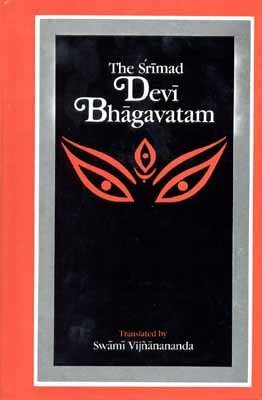The Devi Bhagavata Purana
by Swami Vijñanananda | 1921 | 545,801 words | ISBN-10: 8121505917 | ISBN-13: 9788121505918
The English translation of the Devi Bhagavata Purana. This Sanskrit work describes the Devi (Divine), the Goddess, as the foundation of the world and as identical with Brahman, the Supreme Being. The Devi Bhagavata Purana is one of the most important works in Shaktism, a branch of Hinduism focusing on the veneration of the divine feminine, along w...
Chapter 17 - On the Dhruva Maṇḍalam
1-29. Nārāyaṇa said :-- Beyond the Saptarṣi maṇḍalam (the Great Bear), thirteen lakh Yojanas higher is situated, the Viṣṇu’s Paramam Padam (the highest place of Viṣṇu). The Great Bhāgavat (devotee of God), the most respectful, Śrīmān Dhruva, the son of Uttānapāda, is established there with Indra, Agni, Kaśyapa and Dharma and the Nakṣattras. The visitors pay to him always their respects. He is the patron of those who live till the end of a Kalpa. He is engaged in serving the lotus-feet of the Bhagavān. He has been made by God Himself the pillar round whom all the planets, stars, and the luminary bodies are revolving always and with great force in the Zodiac and in the celestial Heavens. The Devas also worship him. He, resplendent in his own glory, illumines and manifests all. As beasts tied to yoke go on tilling, so the planets and stars, fixed on the Zodiac, go quickly round and round this Dhruva, the Pole Star; some nearer, some further distant in spheres, propelled by Vāyu. As the hawks hover round the sky, so the above-mentioned planets, go completely round and round under their own Karmas and controlled by the Vāyu in the sky. Thus all the luminaries do not fall to the ground, as they are kept up in their respective positions by the favour of the union of Prakriti and Puruṣa. Some say that this Jyotiṣcakra, the celestial Heavens (the Zodiac) is Śiśumāra. It is kept duly in its position for the purpose of holding things up by the power of the Bhagavān. Hence it does not fall. It is resting with its body coiled round and with its head lower down. O Muni! Dhruva, the son of Uttānapāda is staying at the tail end. And, in addition to him, also at the tail rests Brahmā, the Sinless Prajāpati, worshipped by the Gods, Agni, Indra and Dharma. Thus the creation is at the tail and the Saptarṣimaṇḍal is staying at his waist. Thus the celestial wheel (Jyotiṣcakra) is resting with his coils turned in a right-hand direction. On his right side are found the Uttarāyaṇa Nakṣattras, fourteen in number from Abhijit to Punarvasu and on his left side are found the other fourteen Dakṣiṇāyanam Nakṣattras from Puṣyā to Uttarāṣāḍhā. O Son of Brahmā! Thus the Nakṣattras form the coil-shaped body of the Śiśumāra, the Zodiac; half the Nakṣattras on the one side and the other half Nakṣattras on the other. His back is on the Heavenly Ganges named Ajavīthī. Punarvasu and Puṣyā form the right and left side of the loins; Ārdrā and Aśleśā form the right and left feet (westward); Abhijit and Uttarāṣāḍha form the right and left nostrils. O Devarṣi! Śravaṇā and Pūrvāṣāḍhā form the right and left eyes respectively; so say the persons that form the Kalpanās (fancies). Dhaniṣṭhā and Mūlā form his right and left ears; Maghā, etc., the eight Dakṣiṇāyanam Nakṣattras form the bones on the left side. O Muni! Mrigasīrṣa, the Uttarāyaṇa Nakṣattras form the bones on his right side, Śatabhiṣā and Jyeṣṭhā form the right and left shoulders. Agasti (the Canopus) forms the upper jaw and Yama, the lower jaw. The planet Mars forms his face; Saturn forms his organ of generation; Brihaspati forms the hump on the shoulders; the Sun, the Lord of the planets, forms his breast; Nārāyaṇa remains in the heart; and the Moon is in his mind.
(Note :-- Śiśumāra is also the constellation Dolphinus and is sometimes meant for the polar star.) O Nārada! The two Aśvins form the nipples on his breast; Uśanā forms his navel; the Mercury is his Prāṇa and Apāna; Rāhu is his neck and Ketu is all over his body and the stars are reigning all over the hairs of his body. This Zodiac is the body composed of the Devas of that All Pervading Bhagavān. So every intelligent person should daily meditate this Śiśumāra in the Sandhyā time, with perfect purity and keeping himself Mauna (silent), and with his whole heart.
Then he should repeat the following mantras and get up and say :-- “Thou art the Substratum of all the luminaries, we bow down to Thee; Thou createst and destroyest all. Thou art the Lord of all the celestials. Thou art the Ādipuruṣa, the foremost of all the Puruṣas; we meditate fully on Thee. The planets, Nakṣattras, and the stars are Thy body. The Daiva is established in Thee alone. Thou destroyest the sins of those that compose the Mantras. The sins are completely destroyed for the time being of him who bows down or remembers Thee in the morning, afternoon and evening.”
Here ends the Seventeenth Chapter of the Eighth Book on the Dhruva Maṇḍalam in the Mahā Purāṇam Śrī Mad Devī Bhāgavatam of 18,000 verses, by Maharṣi Veda Vyāsa.
